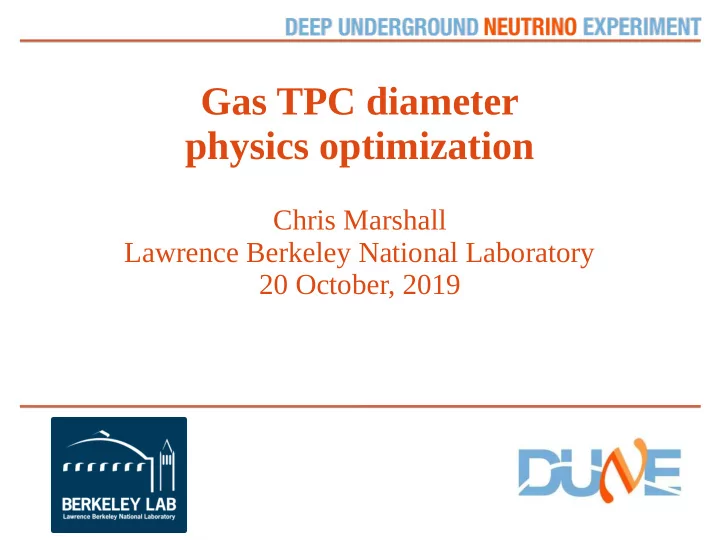

Gas TPC diameter physics optimization Chris Marshall Lawrence Berkeley National Laboratory 20 October, 2019
Motivation & goals ● Space is very tight in the ND hall, especially in the beam direction ● If the HPgTPC can be made smaller, it could dramatically reduce costs of civil construction (hall span, shaft diameter) and other components (ECAL, magnet, muon system), with the caveat that it would require additional cost of new-build readout chambers ● HPgTPC serves two important purposes, as the LAr muon spectrometer and it's own detector ● This talk focuses on the impact of track momentum resolution of different HPgTPC active volume sizes 2 Chris Marshall
Details of study ● Simulate events on Ar using GENIE, distributed uniformly in the gas TPC ● Define fiducial volume 50cm from all edges, such that track curvature can be determined before particles exit ● Determine B x dl for each muon, and use Gluckstern formula to determine momentum resolution ● (assume 1mm point resolution, 100 points per m) 3 Chris Marshall
Resolution vs. pressure, B field, momentum, track length ● Dominated by multiple scattering except at very short track length < 1m 4 Chris Marshall
Resolution vs. pressure, B field, momentum, track length Fraction due to multiple scattering ● Dominated by multiple scattering except at very short track length < 1m ● But measurement term is important for short tracks 5 Chris Marshall
Momentum residual for full F.V. Nominal 5m diameter 3m diameter ● Shades are different bins of muon momentum ● Resolution is worse for smaller detector because a larger fraction of the tracks are short 6 Chris Marshall
Long tracks → better resolution ● Fraction of all fiducial tracks with >2m length in the plane transverse to magnetic field ● ~40% for 4m diameter and ~70% for 7m diameter ● This is the reason why the average momentum resolution depends on radius 7 Chris Marshall
Resolution vs. field strength >2m only ● For 5m diameter, 5m length, 10bar ● Uptick at low momentum is because more tracks are high angle, and point parallel to magnetic field 8 Chris Marshall
Resolution vs. pressure (or density) >2m only ● 5m diameter, 5m length, 0.4T field ● Essentially no impact on momentum resolution 9 Chris Marshall
Resolution vs. length (in x) >2m only ● 5m diameter, 10bar, 0.4T field ● No dependence on length 10 Chris Marshall
Resolution vs. radius >2m only ● 5m length, 10bar, 0.4T field ● Improved resolution due to longer tracks on average, especially at very high momentum ● At 1 GeV/c, difference between 4m and 5m diameter is 1 percentage point 11 Chris Marshall
Comment on momentum resolution ● 2% multiple scattering limited momentum resolution is possible for long tracks >1m ● But average momentum resolution for 1ton fiducial volume will be significantly worse, ~5%, because many tracks will be ~50cm and have poor resolution ● Actual analysis would probably weight events by expected resolution based on track length 12 Chris Marshall
Proton energy threshold vs. density ● Assumes 6cm track threshold ● ~7 MeV for default 10bar, rises to 10 MeV for 20bar (or cooled to twice density) 13 Chris Marshall
Mass vs. diameter, length ● 5 → 4m decreases mass by 36% ● Could be compensated by cooling to ~200K ● Or lengthening cylinder axis to ~7m 14 Chris Marshall
Conclusions ● Reducing the gas TPC diameter from 5m to 4m is a viable option if space in the Z direction is limited, or if costs of the magnet and ECAL are driven by the diameter ● This would have minimal impact on the LAr track matching, and modest adverse impact on the GAr physics: ● Reduces statistics by 36% ● Reduces average momentum resolution from 6% → 7% 15 Chris Marshall
Recommend
More recommend